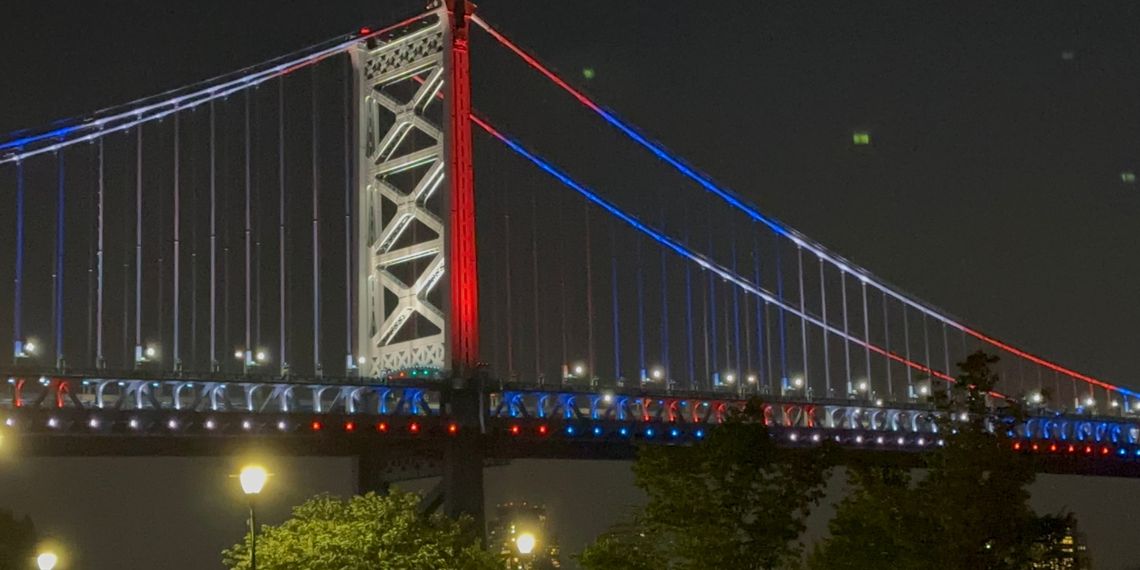ben franklin bridge lighting

Originally constructed in 1922, the bridge has undergone several rehabilitations over the years. Most recently, its lighting system received a multimillion-dollar upgrade to a new LED system.
The Benjamin Franklin Bridge is an iconic structure in Philadelphia – a massive suspension bridge crossing the Delaware River, connecting Center City Philadelphia to Camden, New Jersey.
Originally constructed in 1922, the bridge has undergone several rehabilitations over the years. Most recently, its lighting system received a multimillion-dollar upgrade to a new LED system.
The bridge is known for its decorative illumination, which adds drama to the Philadelphia night sky, especially during holidays and special events. The various effects, such as chasing lights that follow PATCO train cars as they cross the bridge, are a favorite among tourists and residents.
First installed in 1987, the light system was originally comprised of halide spotlights at the bottom and reflectors at the top of each of the bridge's 256 vertical suspender cables, which outline the structure in visible lights. DRPA upgraded the system in 2000 by adding multicolored lights along the bridge deck and more visual effects.
The goal of the new LED System, installed in 2023, was to improve efficiency, facilitate easier maintenance, and enhance programming.
As the prime consultant on the project, Urban was responsible for performing engineering design and construction administration services. This included all phases of the design, upgrade, and replacement of the existing system.
Benjamin Franklin Bridge Decorative Lighting Replacement

Working with The Lighting Practice, Urban designed the new system and replaced more than 1,000 luminaires across the 1.5-mile length of the bridge. The project included exterior lighting and partial interior lighting, lighting controls, lighting supports, electrical equipment, fiber optic network modifications, code compliance, commissioning procedures, and preventative maintenance schedules.
The components replaced included catenary lighting, tower color-changing lighting (partial), lower truss lighting, pedestrian walkway lighting luminaires, anchorage exterior lighting, anchorage interior lighting, lanterns, controls for the catenary lighting, horizon DMX controls, as well as software, hardware, and wiring.
The new lighting system now allows for a more efficient operation and maintenance, as well as a full color spectrum of lighting options for the city to enjoy.
Project highlights:
- The new decorative lighting system utilizes a multicolor light-emitting diode (LED) fixture that uses red, green, blue, and white (RGBW) LEDs to produce color-programmable lighting effects. The new system allows the bridge to be illuminated in many colors, which allows static or dynamic light shows for any holiday or event.
- Existing decorative lighting elements replaced with LED light fixtures, including bridge under deck (“dot”) lighting, walkway level catenary (“suspender”) lighting, and anchorage lighting.
- New decorative LED lighting at the PATCO track level, consisting of approximately 308 fixtures at each umbrella column below the pedestrian walkway.
- New decorative LED lighting at the Camden and Philadelphia Towers, consisting of approximately 84 fixtures mounted to the tower gantries above the roadway, to highlight the towers.
- Replacement of approximately 257 walkway pedestrian fixtures with LED fixtures.
- Restoration of historic light fixtures at the Anchorages.
- Modernized lighting control system utilizing an IP-based system with a dedicated fiber optic network spanning the bridge.
- Upgraded electrical system that centralizes the system's electrical and control equipment at the walkway level for ease of maintenance and increased reliability.